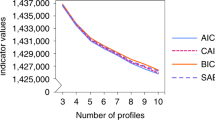Abstract
Validation of Cohen's CAD scale was attempted on a sample similar to that used in the scale's original development. Results were not in accord with the underlying theory. This prompted an attempt to refine the CAD instrument by deletion of ineffective items. The revised scale was examined for reliability and validity. Results were sufficiently weak to suggest that marketers should have diminished confidence in applying CAD as a measure of interpersonal orientation and should initiate development of other approaches for personality assessment.
Similar content being viewed by others
References
Campbell, D. T. and Fiske, D. W. “Convergent and Discriminant Validation by the Multitrait-Multimethod Matrix,”Psychological Bulletin, 56: 81–105, 1959.
Cohen, J.B. “Interpersonal Response Traits and Consumer Behavior,” unpublished doctoral dissertation, U.C.L.A., 1966.
—, “An Interpersonal Orientation to the Study of Consumer Behavior,”Journal of Marketing Research, 4:270–7, August 1967.
Cohen, J.B., and Barban, A.M., “An Interactive Consumer Product Typological System: A Progress Report and Partial Evaluation,” working paper #12, Pennsylvania State University, December 1970.
—, and Golden E., “Informational Social Influence and Product Evaluation,”Journal of Applied Psychology, 56: 54–9, February 1972.
Cronbach, L.J., “Coefficient Alpha and the Internal Structure of Tests,”Psychometrika, 16: 297–334, September 1951.
Evans, F.B. “Psychological and Objective Factors in the Prediction of Brand Choice: Ford versus Chevrolet,”Journal of Business, 32: 340–69, 1959.
Horney, K.B.Our Inner Conflicts, New York: W.W. Norton & Co., 1945.
Kaiser, H.F. “The Application of Electronic Computers to Factor Analysis,”Educational and Psychological Measurements, 21: 141–51, Spring 1960.
Kassarjian, H.H. “Personality and Consumer Behavior: A Review,”Journal of Marketing Research, 8: 409–18, November 1971.
Kernan, J.B. “The CAD Instrument in Behavioral Diagnosis,” D.M. Gardner ed.,Proceedings, Association for Consumer Research, 307–12, 1971.
Noerager, J.P. “An Assessment of CAD: A Personality Instrument Developed Specifically for Marketing Research,”Journal of Marketing Research, 16: 53–9, February 1979.
Nunnally, J.C.Psychometric Theory, New York: McGraw-Hill Book Co., 1967.
Runkel, P.J. and McGrath, J.E.Research on Human Behavior New York: Holt, Rinehart and Winston, 1972.
Ryan, M.J. and Becherer, R.C. “A Multivariate Test of CAD Instrument Construct Validity,” B.B. Anderson ed.,Proceedings, Association for Consumer Research, 149–54, 1975.
Wells, W.D. “Psychographics: A Critical Review,”Journal of Marketing Research,” 12:196–213, May 1975.
Author information
Authors and Affiliations
Rights and permissions
About this article
Cite this article
Sullivan, G.L., O'Connor, P.J. A structural assessment of the original and a modified version of the CAD scale. JAMS 12, 41–51 (1984). https://doi.org/10.1007/BF02721798
Issue Date:
DOI: https://doi.org/10.1007/BF02721798




